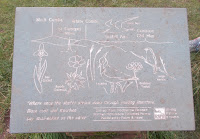Haverigg is at the end of a road that goes nowhere except Haverigg: it is the site of a large caravan and chalet park, with many picnic facilitites
But in the mid 19th century it was, to all intents and purposes, nothing. Then, a fabulous deposit of hematite was discovered and in short order it was the largest iron ore mine in the world. This was tricky as its coastal, and a barrier was required to stop the miners drowning. Ultimately two were built, as the first failed - the barrier's cresent is very clear on the map: No surprises that in the 1960s the mining came to a halt, leaving an odd collection of industrial bits and pieces. And the barrier. It's a nice coastline, so no surprises that the chalet park sprung up, but it's also an RSPB reserve and actually a jolly place to visitCo-curate have some useful stuff describing and illustrating the history.
To reach Haverigg, you need to pass through Millom, which only came into existence in the later C19 as a purely industrial (iron and coal) town. In 1883, my Great-great-grandfather Rowland Penny lived as a lodger at the Red Lion in Millom. Walking home one night, he stopped for a rest in The Ship, halfway up the hill. He died in the bar. The Ship is now a short row of cottage: "Old Ship Cottages".
Rowland had an almost contemporay Millom namesake who died in an explosion in a dynamite factory. A different bloke altogether.





